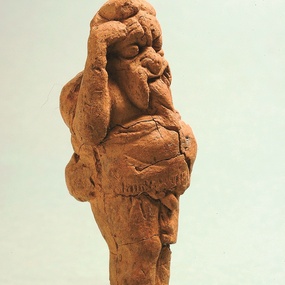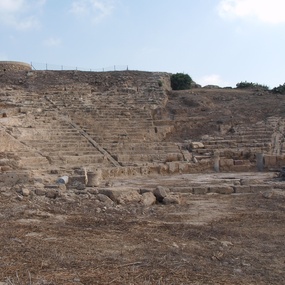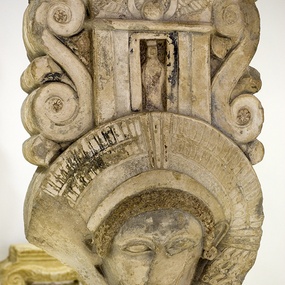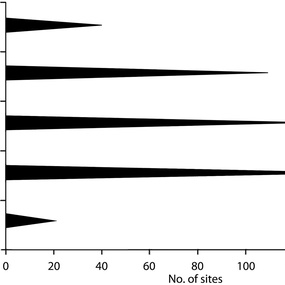During the war of Alexander the Great against the Persians, the Iron Age Cypriote polities, known in the literature as city-kingdoms,were part of the Achaemenid Empire. Despite the fact that they must have been paying some kind of tribute to the Persian monarch and had to provide maritime military assistance to the Persian kings, they maintained their political status and independence. Following Alexander’s death in 323 BC, his diadochoi (successors) used the island as a battleground. In the end, Ptolemy I prevailed in Cyprus, and thus the island eventually became a unitary but provincial state under Ptolemaic rule.1
Iacovou highlights the importance of this event: “Territorial boundaries were lifted, possibly for the first time since the 2nd millennium, and the Cypriotes were forced to become citizens of a unified, but colonial state”.2 This political break had “irreversible consequences” for the individual histories of the Iron Age polities. It is only within the context of the longue durée, however, that such administrative and sociocultural consequences can be understood.
This contribution is an attempt to understand the transition from the era of the Cypriote city-kingdoms to the Hellenistic period through the evidence provided by the archaeological record. More specifically, to understand how event history, namely the political transition from segmented administration by many Cypriote kings, the basileis, to the unitary island-wide government by a foreign Ptolemaic correspondent, the strategos, affected the socio-cultural infrastructure, the mentality, of the island. Aknowledging the fundamental role of religion in ancient societies and the existing availability of the archaeological record under discussion, it has been deemed most appropriate to approach the horizon of the transition through understanding both political and cultural tranformations within regimes of social power and their religious material nature.
The “hellenising” policy of the Cypro-Classical basileis and the incorporation of Cyprus into the Ptolemaic state
If we consider the final phase of the Late Cypriote period (especially the 12th century BC) as the initial stage in the process of a long and multistaged “hellenisation” of the island -when immigrants from the post-Mycenaean world arrived in Cyprus -, in the later 6th century BC - following the initiation of the Graeco-Persian conflict - we can observe a process of realignment with the Greek world of the Late Archaic and Classical periods. The material culture and the textual evidence related to the period under discussion clearly support this statement. These developments are related to a new policy on the part of the Cypriote basileis, which required a shift from eastern to western prototypes.3
Cypriote coinage is strongly indicative of the transition from eastern to western prototypes in the expression of Cypriote royal ideology. In the 5th century BC, Cypriote basileis minted coins bearing the alphabetic script (at first alongside the syllabary) and iconographic features influenced from Greece.4 In addition, iconographic elements bear eloquent evidence of the attempt of most of the Cypro-Classical dynasties to associate their lineage with Greek deities or heroes. Greek or “hellenised” deities are found in the 5th and, even more commonly, the 4th century BC coinage of the city-kingdoms: the figures of Heracles, Apollo, Artemis, and Athena, for example, appear on the coinage of the Salaminian dynasty of the 5th and 4th centuries BC.
This is also the period when Greek divinities, such as Hera, Artemis, Athena, Demeter, and Apollo, appear for the first time in the epigraphic record.5 At the same time, the Cypriote basileis, along with other Cypriotes, also appear as dedicants in major panhellenic sanctuaries.6 Pnytagoras of Salamis, for example, is shown offering laurel and myrtle crowns made of gold at the sanctuary of Apollo in Delos.
Textual and archaeological evidence related to theater further elucidate the character of the “hellenising” policies of the Cypriote basileis toward the last quarter of the 4th century BC. Before Alexander, there is limited theatrical iconography, and it is mainly confined to figurines which, however, in the lack of archaeological context, have usually been dated on stylistic grounds [Fig. 1]. This material should probably be seen in the context of closer links between Greece and the Cypriote city-kingdoms. Theater in mainland Greece is an integral part of political life and cultural identity. The end of the 4th century BC is likely the date when a theater was also built at Nea Paphos [Fig. 2].7
This transition toward a more “hellenised” environment and the impact of the Cypro-Classical royal ideologies on Cypriote culture can also be seen in the development of Cypriote burial practices and sculpture. By the 5th century BC, the use of sarcophagi became quite common, and eventually, as far as can be ascertained, in the 4th century BC we have no construction of built tombs with dromos. This is also the period when the depiction of Greek themes and iconography appears on monumental Cypriote art.8 While male sculpture - some of which should be related to royalty - accommodates Egyptian and Near Eastern symbols of power during the Cypro-Archaic period,9 as we proceed within the Cypro-Classical period, clearly “hellenised” forms prevail.
“Hathoric” iconography represents a good case study of how the expression of royal ideology was transformed from the Cypro-Archaic to the Cypro-Classical period [Fig. 3]. The eclectic placement of “Hathoric capitals” and the context of their discovery (a “palatial” structure or an urban sanctuary) suggest that they functioned as symbols of power rather than as mere fashionable elements. A Cypriote goddess, who is clearly called Aphrodite at least by the late 4th century BC, as manifested in the bilingual inscriptions from Amathous discussed below, continues to show iconographic evidence for assimilation with a former Astarte-like goddess.10 In the 4th century BC, when the Cypriote Astarte-like goddess is assimilated with Aphrodite, the presence of “Hathor” is clearly restricted. We are correct, therefore, in suggesting that the Hathoric figure was important to Cypriote ideology only until the first phase of the Cypro-Classical period.
It is also in the context of the “hellenising” policy of the Cypriote basileis that the “hellenisation” of the “Cypriote Goddess” was initiated in the Cypro-Classical period. The “hellenisation” of the goddess is clearly illustrated on a unique late Cypro-Classical / early Hellenistic Cypriote limestone statue from Golgoi, and now in the Metropolitan Museum of Art.11 The statue portrays the goddess with clear attributes: she is now dressed in the Greek style and wears a high diadem decorated with palmettes alternating with nude Astarte-like figures. The Metropolitan statue wears a necklace of pendant lotus blossoms and on her left arm holds a fragmentary winged Eros, the male Greek companion of Aphrodite par excellence.
Epigraphy further identifies this stage of assimilation between a Cypriote goddess and Aphrodite. By the 4th century BC, the identity of the Amathousian goddess, for example, is clear. Two 4th-century BC dedications found in the Amathous hilltop sanctuary provide key evidence not only about the identity of the goddess but also about her special connection with royal power and ideology: the last basileus of Amathous, Androkles, dedicated statues of his two sons to the goddess, who is clearly called Aphrodite.12
Alexander interfered in the internal matters of Cyprus not through the activity of his own administrative plan, but only as a result of the diplomatic intervention of some Cypriote basileis.13 During the conflict of Alexander’s diadochoi, however, the Cypriote basileis were politically divided. Some of them joined the Antigonids and others the Ptolemies, obviously hoping that by allying themselves with either of the two parties they would retain their independence. Epigraphic, literary, and - at least in the case of Kition and Marion (see below) - archaeological evidence is substantial enough to see the change and the simplification of the political map of the island even before the final abolition of the city-kingdoms.
Diodorus (ΧΙΧ.79.4–5) informs us that Ptolemy, after executing the basileis that allied against him, he appointed Nikokreon, the basileus of Salamis, as general, strategos, of the island, giving him both the city-kingdoms and the revenues of the basileis who had been driven out. The sense of Nikokreon’s strategia remains open to interpretation.14 The contemporary scholar must consider the fact that precise information from ancient historians, especially from Diodorus, is hard to come by, and only new documentary evidence is likely to allow us to speak with confidence about the Ptolemaic strategia on the island before the end of the 3rd century BC and, more specifically, before 217 BC, when the first explicit evidence for a Ptolemaic strategos can be found.
Sacred Landscapes from basileis to strategos
Acknowledging the potential of landscape studies to provide a major source of new interpretations in the long term, let us attempt to re-work on and re-experience not only the Cypriote sacred landscapes of the transition from basileis to strategos, but also to further illuminate the political and socio-cultural histories of both these periods. This approach falls within the framework of an on-going project entitled ‘Unlocking’ Sacred Landscapes: A Holistic Approach to Cypriot Sanctuaries and Religion.15
The continuity of cult activity from the Cypro-Classical to the Ptolemaic period is confirmed by the great number of sanctuary sites that survive into the Hellenistic period and, particularly, by sites that survive well into the Roman period [Fig. 4]. Nevertheless, since the number of Cypriote sanctuary sites that did not survive into the Hellenistic period (or were abandoned within it) is substantial, the assumption that religious activity was nowhere discontinued is improbable. It is more likely that we should attribute the abandonment of many cult sites primarily to political acts of the basileis in the Cypro-Classical period and, secondarily, to subsequent Hellenistic social developments.16
In the case of the Amathousian “palace”, it is possible to assess the direct relationship between political elites, economic activity, and religion for the era of Cypriote kingdoms.17 The “palace” with its sanctuaries was destroyed or abandoned at the end of the Cypro-Classical period.18 This destruction/abandonment seems to have been an episode connected with the abolition of the city-kingdoms and, consequently, with the military and political acts of the Hellenistic diadochoi. The only other sanctuary sites where, based on literary and excavated evidence, destruction has been attributed to the Ptolemies are the sanctuaries of Kition, Tamassos, and Marion.19 If we consider the epigraphic and literary evidence relating to the attitude of the Cypriote basileis during the conflict of the diadochoi — that is, the alliance of Kition and Marion with the Antigonids against the Ptolemies — the destruction of these sanctuaries should be attributed to a political rather than a religious, cultural, or “ethnic” war.20 On the other hand, the main sanctuaries, located within the immediate environs of certain urban centers, such as those of Aphrodite in Palaepaphos and Amathous, and the sanctuary of Apollo Hylates at Kourion, continued to flourish during the Hellenistic period, without any disruption. Likewise, a considerable number of extra-urban sanctuaries survived well into the Hellenistic period.
The proliferation of extra-urban sanctuaries had taken place during the Cypro-Archaic period.21 Iacovou, in attempting to reconstruct the political map of the island in the Iron Age, has shown that the number of kingdom polities, and consequently their territories, would have fluctuated, but the number of polities was gradually diminishing;22 therefore, certain kingdom territories were expanding. Hence, the discontinuity of some extra-urban sanctuaries could perhaps be associated with territorial claims, as in the case of the political acts of the basileis of Salamis and Kition which, during the 5th and 4th centuries BC, caused their regions to be enlarged.
Various Geographic Information Systems (GIS) analyses complement other archaeological evidence, which provide evidence for the territoriality of some Iron Age extra-urban sanctuaries. For example, GIS analyses suggest that the sanctuary site of Vavla-Kapsales belonged to the territory of Amathous [Fig. 5]. Following previous discussion on the subject,23 the sanctuary should be seen as a ‘frontier sanctuary’, which could have stood between the city-kingdom of Amathous, Idalion, Kition and Tamassos. The sanctuary had an important hierarchical position in the economic life of the area: its topographical setting relates to the copper mines and the surrounding areas of agricultural production24.
The transformation of political topographies in Cyprus during the Hellenistic era brought marked changes in urban and extra-urban contexts. It should be expected that the shifting roles of the urban centers, from capital centers to provincial cities, or from cities to small towns or villages in some instances, also had an impact on sacred landscapes. As the epigraphic evidence reveals, new social divisions and affiliations within the Cypriote society as a whole, but also within individual communities, were promoted through the agency of cult. However, during the Hellenistic period, the need of political elites to define the link between territory and city, for reasons other than administrative or economic ones, should have become less and less important. How the cities functioned in Cyprus during the early years of Ptolemaic rule (grosso modo the 3rd century BC) remains to be identified. Still, in a new, unified political organisation which was probably not fully established before the 2nd century BC (following the appointment of a strategos on the island), extra-urban sanctuaries eventually lost one of their most significant functions: their allusion to territorial claims.
Ex novo foundation of Hellenistic sanctuaries on the island is rather limited. We should associate these new sanctuary sites either with the creation of new communities and the foundation of new settlements and cities, or with the propagation of Ptolemaic ideology.25 Textual evidence records the construction of temples, but their remains seldom survive. Exceptions can be found at the temple of Zeus at Salamis, for example, built on a podium at the end of the 2nd century BC. Although scholars have to consider problems of archaeological visibility, one can hardly deny that, even among the strong “hellenising” policy of various Cypro-Classical basileis, classic Greek temple forms did not appear on Cyprus before the Hellenistic period, and it would seem that even then the type was not prevalent; it was restricted to the coastal urban centers.
The ideological authority in the landscape can often be discerned by considering the concepts underlying the construction of monumental architecture. Beside the Ptolemaic official attention toward old traditional urban sanctuaries, which we know about through epigraphic evidence from Palaepaphos and Amathous, for instance,26 it can be observed that Greek-style temple architecture was added to the Cypriote sacred landscapes not in the extra-urban environment of Cyprus but directly in, or in the vicinity of, the major urban centers where Ptolemaic power and cult would have been practiced more markedly. Furthermore, during the early Hellenistic period, ex novo sanctuaries, such as that of Soloi-Cholades, with strong allusions to Ptolemaic cult, were built following the traditional Cypriote architecture of the Iron Age Cypriote temenos, probably drawing on the existing religious sentiment and cult practice.27
The epigraphic evidence of the 2nd and 1st centuries BC suggests that state ideology was closely connected with ritual events, supported by state institutions, groups and political-religious associations, such as the gymnasia and theaters, the Basilistai, and the various thiasoi and koina.28 The most important bearer of a unifying ideology, however, was presumably the Koinon Kyprion (Union of Cypriots). A similar religious function was probably exercised by the koinon ton peri ton Dionyson techniton (guild of the Dionysian artists). The guild consisted of travelling artists who organised theatrical performances and enjoyed the protection of rich patrons, among them the kings themselves. The manipulation of the ceremonial system was clearly an important source of power. Specialised roles, such that of the high-priest, attributed to the strategos, specialised priesthoods coming from the circle of the kings’ friends, and symbolic associations of the kings with some deities, created a politico-religious space shaped by various power relations.
Conclusions
As shown in the previous sections, the transition toward a more “hellenised” environment already within the Cypro-Classical period relates to the local royal ideologies and the will of the Cypriote basileis to form part of the Mediterranean networks, in order to secure economic development and political stability. The shifting of power in the Mediterranean and on the island itself worked as a catalyst, and the end of the city-kingdom institution was only a natural process: a change in the geopolitical situation of Cyprus, a change in ruling large empires, and the internal conflicts of the local basileis made Cypriote basileia unlikely to hold on.29
Given that cult and cult practices have the potential to both express and shape changes in power structures, the investigation of sacred landscapes provides a methodological tool to approach the various stages before and after the transition from Classical to Hellenistic times. The neglect of the extra-urban sacred space on behalf of the state in the Hellenistic period may signal a fundamental (though slow and usually non-violent) transformation of the perception of the political space —that is, the lack of need to define territorial boundaries. After the end of the kingdoms, the survival of extra-urban sanctuaries would have been greatly dependent upon local populations. When the social memory that kept sanctuaries active faded, the sanctuaries themselves faded with it.
This may explain why by the Roman period, the great majority of Hellenistic extra-urban sanctuaries in Cyprus were abandoned. The Cypriote evidence seems to confirm what Alcock has observed in the case of the Hellenistic and Roman sacred landscapes in Greece:30 that what usually distinguishes the surviving sites is what the defunct sites lacked: political scale and significance. The annexation and provincialisation of Cyprus, with all the consequent developments, were accompanied by transformations in patterns of memory, with less focus on regional or local structures, and more intense emphasis on stressing an ideology that created a more widely recognisable “pan-Cypriote” myth-history and identity.









